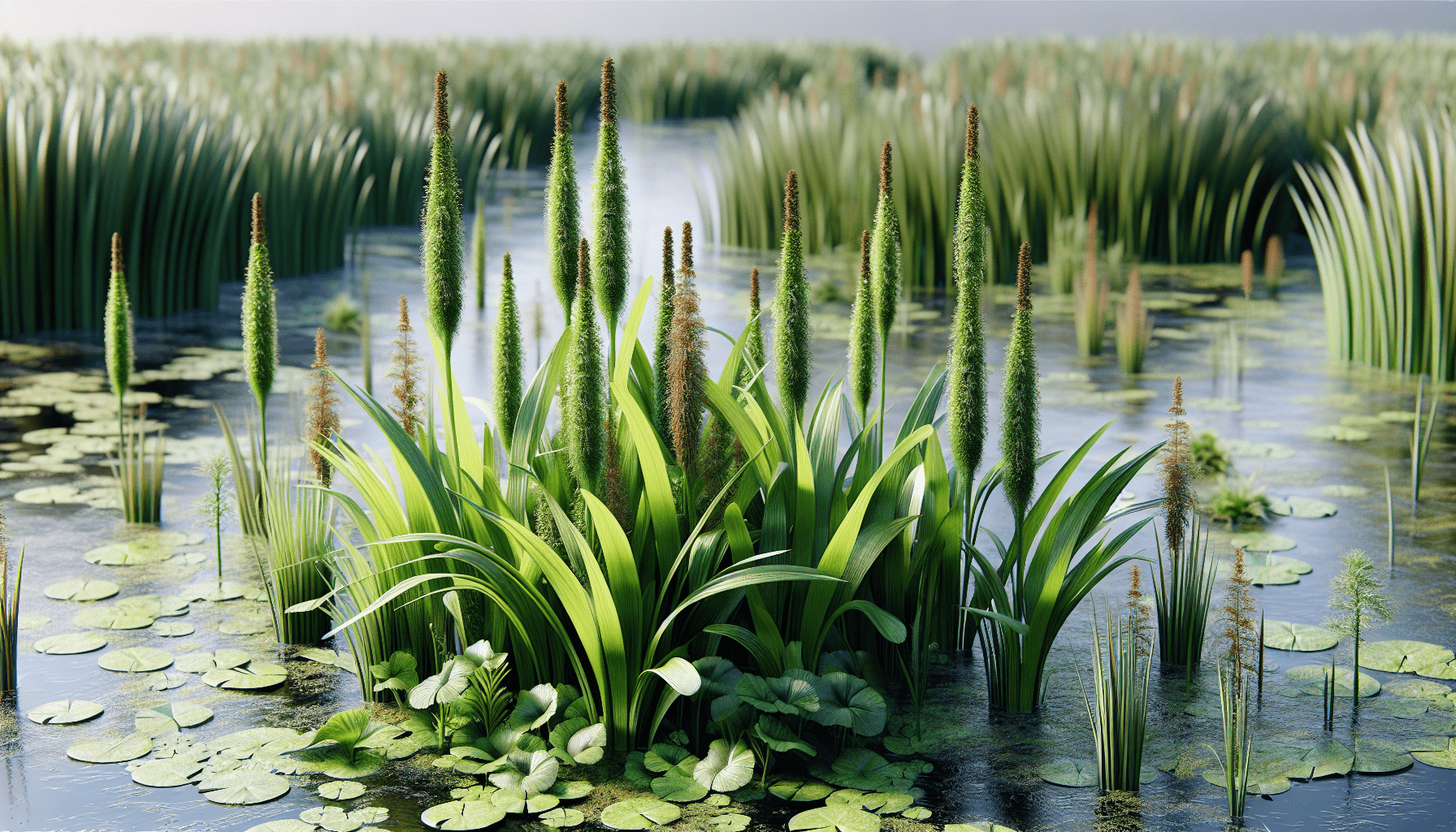Understanding the aquatic weed Acorus Gramineus requires acknowledging its ecological significance, cultural history, and current roles in both ornamental horticulture and traditional medicine. While terms like “aquatic weed” can often denote negative connotations, it is paramount to dispel such an assumption as you engage with this text. Herein, you will find an academically-grounded exploration about this multi-faceted plant, encompassing its taxonomy, unique attributes, proliferation, and utilitarian applications – a comprehensive discourse that promises to transfigure your view on Acorus Gramineus from a mere water weed into a complex biological entity.

Origins and Spread of Acorus Gramineus
Ancestral origins and regions of this aquatic weed
Acorus gramineus is a perennial, semi-aquatic, and marginal plant native to East Asia, specifically in regions including Japan, Korea, and China. Notably, it is a species from the genus Acorus, which forms some of the earliest divergent lineages within the monocotyledons. Over time, the aquatic weed has spread significantly outside its native regions.
Natural and human-aided methods of propagation globally
The global spread of Acorus Gramineus is attributable to both natural and human-aided methods. Naturally, the plant propagates through the division of its rhizomes, which are often carried by water currents to new locations. Human activities, such as the trade of aquatic plants, have led to its global dissemination. The plant’s ornamental appeal has contributed to it being transported around the world for use in water gardens and ponds.
Identifying Features of Acorus Gramineus
Description of physical characteristics both above and below water
Acorus Gramineus, commonly known as sweet flag or grassy-leaved sweet flag, is identifiable by its grass-like leaves that grow directly from the rhizomes. Above the water, the plant has slender, erect, and dark green leaves that can reach up to 30 cm in length. The leaves are sword-shaped and have a firm texture, while the flowers are minuscule in size and are densely packed into cylindrical spikes. Below the water surface, the plant has elongated, creeping rhizomes that are thick, soft, and have a pungent smell.
Seasonal growth and changes in appearance
Acorus Gramineus is a hardy plant, able to withstand variations in seasonal conditions. In spring and summer, the plant is at its most vibrant, with rich green, flattened leaves standing erect above the water. During fall, the leaves start to turn yellowish-brown, eventually dying back in the winter, only for the rhizomes to sprout fresh shoots in the spring.
Natural Habitat of Acorus Gramineus
Typical water bodies where the weed thrives
Acorus Gramineus typically thrives in shallow water bodies or waterlogged soils, such as marshes, swamps, and the edges of ponds and lakes. They grow optimally where there is ample sunlight, but they can also tolerate moderate shade.
Climate conditions suitable for growth
The plant’s native climate is temperate with mild winters, but it has shown a remarkable ability to adapt to different weather conditions. It tolerates both hot summers and freezing winters, making it resistant to various climatic conditions.
Life Cycle of Acorus Gramineus
Stages and duration of reproductive and non-reproductive phases
As a perennial plant, Acorus Gramineus goes through both reproductive and non-reproductive phases within its life cycle. The reproductive stage, occurring in spring and summer, is when the plant produces flowers — small, yellow-green spadices. During fall and winter, the non-reproductive phase, the plant ceases flowering and withdraws into its rhizomes for the winter dormancy.
Environmental triggers for each phase of development
Various environmental conditions trigger the different phases in Acorus Gramineus’s life cycle. The onset of spring conditions, marked by warmer temperatures and increased daylight, triggers the plant’s reproductive phase. Conversely, reduced daylight and lower temperatures mark the onset of the plant’s non-reproductive phase or dormancy.

Reproduction Methods of Acorus Gramineus
Different modes of dispersion and reproduction
Acorus Gramineus reproduces both sexually and asexually. Sexual reproduction involves seed production after flower pollination. However, the most prevalent mode of reproduction is asexual, through multiplication and dispersion of rhizomes. These portions of rhizomes can be transported by water currents or inadvertently by animals or humans, starting a new plant wherever they end up.
Role of the environment and other factors in reproduction
The environment plays a crucial role in the reproduction of Acorus Gramineus. Water availability, temperature, light, and soil type all influence the plant’s growth and reproduction. For instance, the aquatic weed prefers marshy, wet soils rich in organic matter. Without these conditions, the plant’s growth and propagation can be stifled.
Ecological Role and Interactions of Acorus Gramineus
Its place and role in the ecosystem
In its natural habitats, Acorus Gramineus performs several ecological roles. The plant serves as a shelter for small aquatic animals while its seeds provide food for various water birds. Furthermore, the dense growth of this aquatic weed can also prevent soil erosion by stabilizing riverbanks and shores of water bodies.
Interactions and relationships with other aquatic life
The species co-exists with various other aquatic life forms, establishing mutual relationships. Some small aquatic creatures use the weed for cover against predators and as a breeding ground. While in some regions, waterfowl feed on its seeds, contributing to its dispersion.
Economic Impact of Acorus Gramineus
Impact on fishing, water sports, and other water-based activities
When Acorus Gramineus grows uncontrollably, it can seriously impede water-based activities. It can obstruct fishing activities by making it difficult to draw nets through densely covered areas. Besides, excessive growth can interfere with water sports and leisure activities such as boating, swimming, and canoeing, thereby affecting the revenue from these activities.
The cost of control and removal operations
The prolific growth of Acorus Gramineus can result in substantial public spending for its control and removal. These operations often require significant management and labor inputs, which translate into high costs. Hence, unchecked proliferation of this aquatic weed has negative economic implications.
Methods of Controlling Acorus Gramineus
Common techniques and strategies for controlling growth and spread
There are several methods to control the spread of Acorus Gramineus. Mechanical control includes manually removing the plant or using machinery in heavily infested locations. Chemical control methods involve the targeted application of approved herbicides. Biological control, while less common, is an option where specific pathogens or herbivores are used to restrict the plant’s growth.
Effectiveness and impact of control methods
Each control method’s effectiveness varies based on the infestation level and local environmental conditions. While mechanical control provides immediate results, it might not be entirely effective as it may leave fragments that can regenerate. Chemical methods can be more effective, but they carry potential risks for other non-target species and the surrounding environment. Biological control serves as a less damaging but slow-acting alternative.
Potential Uses and Benefits of Acorus Gramineus
Uses in traditional medicine and current research into health benefits
Despite being an invasive weed, Acorus Gramineus has potential beneficial uses. For instance, it has been used in traditional Chinese medicine for centuries to treat various ailments, including convulsions and gastrointestinal disorders. Current research suggests that it possesses anti-inflammatory, antimicrobial, and even potential cancer-fighting properties.
Potential uses in landscaping and decoration
Owing to its ornamental appeal, Acorus Gramineus is widely used in landscaping. Due to its vibrant green foliage and its ability to grow in waterlogged conditions, it is an appealing option for water gardens, ponds, or wet areas of the landscape where other plants may not thrive.
Conservation Status and Legal Protection
Present conservation status locally and globally
Due to its extensive spread and tendency to become invasive in some regions, Acorus Gramineus is not currently under any conservation concern. Indeed, the main focus lies in managing its excessive growth to prevent it from displacing local flora in non-native regions.
Legal protections and restrictions related to Acorus Gramineus
Different regions globally have varying legal protections and restrictions concerning Acorus Gramineus. In some places, where it is deemed invasive, there may be regulations in place prohibiting its cultivation, sale, and introduction into new areas. Understanding and adhering to these local regulations is essential to prevent the environmental impacts of uncontrolled spread of this plant.